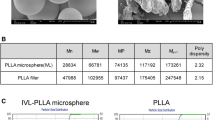Abstract
Injectable dermal fillers, which are used for various plastic surgery purposes, are experiencing explosive market growth due to increasing interest in appearance management. Hyaluronic acid (HA) hydrogels have been considered an ideal material for fillers due to their high-water retention, biodegradability, and biocompatibility. However, their application is limited by shortcomings in durability and persistence caused by rapid enzymatic degradation. Therefore, in this study, we introduce acetylated hyaluronic acid-divinyl sulfone (AcHA-DVS) hydrogels for a novel approach for improving the physical properties and gel retention time of HA. The AcHA-DVS hydrogels showed significant advantages in terms of longevity and performance as dermal fillers compared to HA-DVS hydrogels. These results suggest that our new AcHA-DVS hydrogel is a promising biomaterial as an injectable filler or scaffold for tissue engineering.
Similar content being viewed by others
Availability of Data and Materials
For data requests, please contact the authors.
Abbreviations
- AcHA-DVS:
-
acetylated hyaluronic acid-divinyl sulfone
- HA:
-
hyaluronic acid
- DVS:
-
divinyl sulfone
- MTT:
-
3-[4, 5-dimethylthiazol-2-yl]-2, 5 diphenyl tetrazolium bromide
- Wd :
-
dry mass weight
- Ws :
-
swelling mass weight
- ESR:
-
equilibrium swelling ratio
- DMSO:
-
dimethylsulfoxide
- DMEM:
-
Dulbecco’s modified Eagle’s medium
- FBS:
-
fetal bovine serum
- P/S:
-
penicillin-streptomycin
- Calcein-AM:
-
calcein acetoxymethyl ester
- FE-SEM:
-
field emission scanning electron microscope
References
K. P. Redbord, M. Busso and C. W. Hanke, Dermatol. Ther., 24, 71 (2011).
J. A. Burdick and G. D. Prestwich, Adv. Mater., 23, H41 (2011).
S. Khunmanee, Y. Jeong and H. Park, J. Tissue Eng., 8, 2041731417726464 (2017).
X. Wang, J. He, Y. Wang and F. Z. Cui, Interface Focus, 2, 278 (2012).
X. Xu, A. K. Jha, D. A. Harrington, M. C. Farach-Carson and X. Jia, Soft Matter, 8, 3280 (2012).
C. Chircov, A. M. Grumezescu and L. E. Bejenaru, Rom. J. Morphol. Embryol., 59, 71 (2018).
K. Y. Choi, K. H. Min, J. H. Na, K. Choi, K. Kim, J. H. Park, I. C. Kwon and S. Y. Jeong, J. Mater. Chem., 19, 4102 (2009).
S. P. Zhong, D. Campoccia, P. J. Doherty, R. L. Williams, L. Benedetti and D. F. Williams, Biomaterials, 15, 359 (1994).
S. C. Choi, M. A. Yoo, S. Y. Lee, H. J. Lee, D. H. Son, J. Jung, I. Noh and C. W. Kim, J. Biomed. Mater. Res. Part A, 103, 3072 (2015).
S. Manchun, C. R. Dass, K. Cheewatanakornkool and P. Sriamornsak, Carbohydr. Polym., 126, 222 (2015).
B. B. Mendes, A. C. Daly, R.L. Reis, R. M. A. Domingues, M. E. Gomes and J. A. Burdick, Acta Biomater., 119, 101 (2021).
S. P. Fundaro, G. Salti, D. M. H. Malgapo and S. Innocenti, Int. J. Mol. Sci., 23, 10518 (2022).
E. J. Lee, E. Kang, S. W. Kang and K. M. Huh, Carbohydr. Polym., 244, 116432 (2020).
R. Langer and J. P. Vacanti, Science, 260, 920 (1993).
D. S. Kohane and R. Langer, Pediatr. Res., 63, 487 (2008).
R. Song, M. Murphy, C. Li, K. Ting, C. Soo and Z. Zheng, Drug Des. Dev. Ther., 12, 3117 (2018).
K. Bergman, C. Elvingson, J. Hilborn, G. Svensk and T. Bowden, Biomacromolecules, 8, 2190 (2007).
J. Kablik, G. D. Monheit, L. Yu, G. Chang and J. Gershkovich, Dermatol. Surg., 35, 302 (2009).
S. R. Smith, D. Jones, J. A. Thomas, D. K. Murphy and F. C. Beddingfield,3rd, Arch. Dermatol. Res., 302, 757 (2010).
N. Lin, S. Wei, T. Xia, F. Hu, J. Huang and A. Dufresne, RSC Adv., 4, 49098 (2014).
I. Dueramae, M. Yoneyama, N. Shinyashiki, S. Yagihara and R. Kita, Int. J. HeatMass Transf., 132, 997 (2019).
S. J. Kim, K. J. Lee and S. I. Kim, J. Appl. Polym. Sci., 92, 1473 (2004).
J. Zhu and R. E. Marchant, Expert Rev. Med. Devices, 8, 607 (2011).
T. Walimbe, S. Calve, A. Panitch and M. P. Sivasankar, Acta Biomater., 87, 97 (2019).
V. Cannella, R. Altomare, V. Leonardi, L. Russotto, S. Di Bella, F. Mira and A. Guercio, Biomed Res. Int., 2020, 8676343 (2020).
E. J. Oh, S. W. Kang, B. S. Kim, G. Jiang, I. H. Cho and S. K. Hahn, J. Biomed. Mater. Res. Part A, 86, 685 (2008).
C. Somaiah, A. Kumar, D. Mawrie, A. Sharma, S. D. Patil, J. Bhattacharyya, R. Swaminathan and B. G. Jaganathan, PLoS One, 10, e0145068 (2015).
Acknowledgements
This work was supported by Basic Science Research Program (NRF-2020R1A2C2100794, NRF-2022R1A2C1010161) of the National Research Foundation (NRF) and Korean Fund for Regenerative Medicine (KFRM) grant (22A0104L1) funded by the Korea government.
Author information
Authors and Affiliations
Contributions
E. J. Lee analyzed the characteristics of HA hydrogels. K. H. Park performed cell culture for the cytotoxicity test of the hydrogels. S.-J. Gwak and Y. B. Lee are the major contributors to writing the manuscript. K. M. Huh and S.-W. Kang supervised the study. All authors have read and approved the final manuscript.
Corresponding authors
Additional information
Consent for Publication
All authors have consented to the submission of this manuscript for publication.
Competing Interests
The authors declare that they have no conflict of interest.
Rights and permissions
About this article
Cite this article
Gwak, SJ., Lee, Y.B., Lee, E.J. et al. The use of acetylation to improve the performance of hyaluronic acid-based dermal filler. Korean J. Chem. Eng. 40, 1963–1969 (2023). https://doi.org/10.1007/s11814-023-1496-x
Received:
Revised:
Accepted:
Published:
Issue Date:
DOI: https://doi.org/10.1007/s11814-023-1496-x




